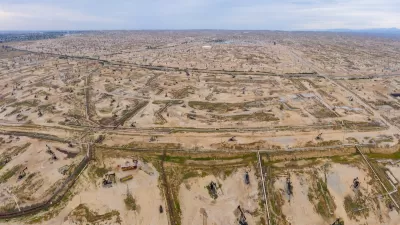Climate action plans cannot succeed without bona fide action on social equity and job creation, argues Murtaza Baxamusa who teaches planning at USC and develops affordable housing Murtaza Baxamusa.
While many of the climate action plans, now adopted in over 120 cities and counties, pay lip service to social and economic justice, too few contain concrete and specific actions at a level equal to the environmental standards of the documents, argues Murtaza Baxamusa, Ph.D., AICP, who develops affordable housing for the San Diego Building Trades Family Housing Corporation and teaches urban planning at the University of Southern California (USC).
"Sustainability is framed as a three-legged stool consisting of the three ‘E’s: environment, economy and equity. However, the third leg, social and economic equity, is often the weakest," says Baxamusa.
He goes on to note:
In an earlier article, I have argued that community empowerment is a necessary condition for sustainability. This is because empowerment balances out the forces that make our world unsustainable. I will further argue that sustainability itself can distribute justice, creating a benevolent reinforcing cycle between empowerment, engagement and equity. For example, sustainable modes of commuting like transit, walking and biking promote social movements through increased social interactions in the public domain. And consequently, these social movements both use and politically support these modes.
Baxamusa also proposes three strategies for "integrating equity within climate actions plans:"
- Establish enforceable thresholds for equity issues such as poverty/income, affordable housing, transportation/transit, and targeted socio-economic benefits.
- Integrate equity in the administration and implementation of all environmental plans, policies and regulations throughout city departments.
- Institutionalize diversity in terms of both leadership, as well as in outreach among stakeholders.
FULL STORY: Why climate change action cannot succeed without social equity

Planetizen Federal Action Tracker
A weekly monitor of how Trump’s orders and actions are impacting planners and planning in America.

San Francisco's School District Spent $105M To Build Affordable Housing for Teachers — And That's Just the Beginning
SFUSD joins a growing list of school districts using their land holdings to address housing affordability challenges faced by their own employees.

The Tiny, Adorable $7,000 Car Turning Japan Onto EVs
The single seat Mibot charges from a regular plug as quickly as an iPad, and is about half the price of an average EV.

With Protected Lanes, 460% More People Commute by Bike
For those needing more ammo, more data proving what we already knew is here.

In More Metros Than You’d Think, Suburbs are Now More Expensive Than the City
If you're moving to the burbs to save on square footage, data shows you should think again.

The States Losing Rural Delivery Rooms at an Alarming Pace
In some states, as few as 9% of rural hospitals still deliver babies. As a result, rising pre-term births, no adequate pre-term care and "harrowing" close calls are a growing reality.
Urban Design for Planners 1: Software Tools
This six-course series explores essential urban design concepts using open source software and equips planners with the tools they need to participate fully in the urban design process.
Planning for Universal Design
Learn the tools for implementing Universal Design in planning regulations.
Smith Gee Studio
City of Charlotte
City of Camden Redevelopment Agency
City of Astoria
Transportation Research & Education Center (TREC) at Portland State University
US High Speed Rail Association
City of Camden Redevelopment Agency
Municipality of Princeton (NJ)





























